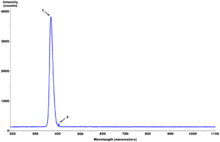Talk:Optical brightener
| This article is rated Start-class on Wikipedia's content assessment scale. It is of interest to the following WikiProjects: | |||||||||||||||||||||||||||||||
‹See TfM›
| |||||||||||||||||||||||||||||||
Untitled
[edit]Is optical brightener the same thing as blue(ing)? --Twid 18:14, 30 August 2005 (UTC)
- No; the illusion is the same, but blueing absorbs red & green, while brighteners use fluorescence to boost the blue. See blueing.--Joel 22:44, 26 April 2007 (UTC)
Toothpaste
[edit]Should we mention their use in toothpastes? Also, they play a minor role in the book Breakfast of Champions.--Joel 22:44, 26 April 2007 (UTC)
Optical Brighteners Are Not Laundry Detergent
[edit]The title of this page is optical brightener not detergent. Optical brighteners have many more applications than laundry detergent including paper, textiles, plastics, and biomarkers. Most of this page, as it is now, concerns laundry detergent applications and should be moved to the laundry detergent page. Infact this page looks like a fabric care page from a detergent manufacturer. I added an external link to a much better treatment of the fluorescent brightener subject in the hope that someone with more time than I have might incorporate it into this wiki page.
Paper brightness (whiteness?)
[edit]As for now, the article states:
Paper brightness is typically measured at 457nm; well within the fluorescent activity range of brighteners.
Why 457 nm? Why “brightness”, a non-technical term?
Paper whiteness is calculated upon CIE xy chromaticity, which implies full-range retinal sensivity, and, in this particular case, D65 illuminant, which is broadband daylight.
Moreover, wavelength of 457 nm corresponds to blue-cyan, which is very doubtful candidate for “brightness” of any kind. I suppose that even 555 nm green, which has the maximum photopic luminous efficacy, can't be a measure of “brightness”, just like every single wavelength. 213.234.235.82 (talk) 14:03, 25 April 2008 (UTC)
Emitted wavelengths range
[edit]As for now, the article states:
…re-emit light in the blue region (typically 420-470nm).
But widely available consumer papers yield the range of 420–580 nm. I've tested several types of media with the same result:
| Paper type | Appearance (day) | Reflectance factor (420–580 nm) |
|---|---|---|
| Epson Ultra Glossy | ultra white | 19.5 peak at 450 nm and 17.6 at 480 nm, 9.3 average |
| generic office paper | bright white | 15.6 peak at 450 nm, 7.6 average |
| HP Advanced Photo Paper | bright white | 10.6 peak at 457 nm, 5.6 average |
| generic writing paper (old) | slightly yellowish | 2.5 peak at 463 nm, 1.8 average |
| generic drawing album (old) | yellowish | 1.9 peak at 477 nm, 1.4 average |
So, as you can see, even papers that look like not having FWA, actually “reflect” more visible light than actually incidents them.
As examples of contrary behaviour, newspaper (2 years, light-gray) and an old book (30 years, very yellowish) do not react to UV at all, reaching a maximum of 0.85 at 570–680 nm.
The properties of the UV-lamp used for this test should not be concerned about, because rules imply that there is very little dependence on the wavelength of exciting radiation. Really, even blue screen of computer monitor or projector can trigger the process of fluorescense: it is easily observed with orange or yellow marking pens. But for those who are curious, the specs are disclosed.

- This UV-lamp has peak at 375 nm and effective range of 360–410 nm (rougly like one on the right).
- Spectral density of majority of emitted visible light (413–727 nm) is three orders of magnitude (1100 times) smaller than UV-maximum, providing very dim light in dark room.
- There is a small IR-part in the measured range of 730–750 nm, carrying some energy around 1.27 % of UV-part. Of course, it doesn't affect visual perception at all.
So, I recommend that someone re-checks this using other materials, other UV-lamp and other measuring equipment (the mine is X-Rite Eye-One Pro rev.D with ArgyllCMS 0.70 for high-resolution readings), and then updates the article.
213.234.235.82 (talk) 15:18, 25 April 2008 (UTC)
Hey, I don't know how to add a citation but for the citation needed on the decreasing of paper whiteness I found https://www.tandfonline.com/doi/abs/10.1179/019713607806112251?cookieSet=1 — Preceding unsigned comment added by 67.189.86.222 (talk) 02:02, 14 December 2018 (UTC)



